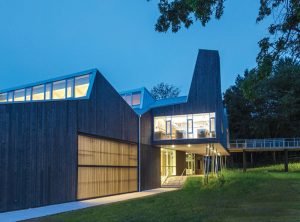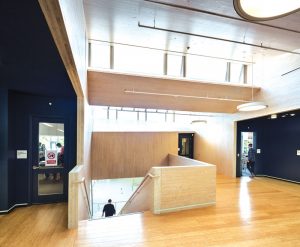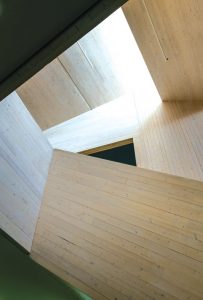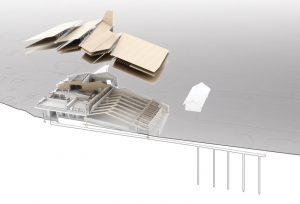Common Ground High School in New Haven, Connecticut
At Common Ground High School, environmental management is both a subject for study and a daily activity. This small public charter school in New Haven, Connecticut, serves 225 high schoolers and, through its umbrella organization, The New Haven Ecology Project, engages an additional 12,000 children and adults from New Haven’s inner city and metropolitan communities in a range of ecologically-focused campus activities throughout the year.

The new building at Common Ground High School connects to the original campus via a mass timber footbridge.
A building committee comprised of Common Ground faculty, administrators, and students commissioned a design team from Gray Organschi Architecture to collaborate with their school to develop a new art studio, science classrooms, and a community meeting and recreation facility that would border the educational farm complex that lies beneath New Haven’s West Rock Park. They challenged the designers to create a building that embodied the ideas of sustainability, self-sufficiency, and environmental health so critical to the school’s pedagogical mission. In response, a design that utilized renewable resources in the building’s structural assemblies and architectural surfaces was developed.
Among an array of sustainable technologies at work in the Common Ground building, the implementation of emerging “mass timber” structural components is perhaps the school’s most novel feature. Designed to the 2005 Connecticut Building Code as a Type V-B fully sprinklered building, the new 14,600-square-foot addition to Common Ground’s campus features an innovative mass timber structure with a prefabricated system of wall and roof components developed by Gray Organschi Architecture and structural engineer Chris Carbone of the Bensonwood fabrication team.

The school’s second-floor lobby highlights the use of cross-laminated timber as both a finish and structural material.
Glued-laminated timber beams and cross-laminated timber (CLT) panels form the building’s structure and, in large part, its interior finish. Five-ply CLT makes up the central bearing walls and elevator shaft, working in conjunction with lumber shear walls to resist lateral loading, and line the large open stairway at the center of the building. Three-ply black spruce CLT provides the tension surface in cellulose-insulated stressed-skin panels that span the school’s classrooms and circulation spaces. Glued-laminated Southern Pine beams aggregate to form a 90-foot bridge connecting the new building to the existing campus. Sixty-six-foot-long glued-laminated black spruce timber ridge trusses – assembled with custom-fabricated steel connections – support glued-laminated roof rafters which in turn span the large multipurpose room that functions as a gymnasium, theater, and community meeting space.
The use of these mass timber assemblies required careful attention to the lateral loading requirements, with the new building designed to a seismic R factor of 6½. The glued-laminated bridge is a buckling restrained frame with non-moment resisting beam-column connections. For the building, hurricane wind loads governed over seismic forces and are resisted primarily with the lumber shear walls sheathed with wood structural panels and assisted by the CLT bearing walls.
Although the project is located in a Wind Exposure Category B zone inland from the Connecticut coastline and is sheltered by a mountain ridge, the relatively light weight-to-area ratio of mass timber assemblies dictated that wind load – rather than seismic load – ultimately governed the design of the lateral system. To improve the CLT’s ductility for lateral loads, ½ lap joints and screws connect the CLT panels used in the wall and roof applications. Within the insulated stressed-skin panels spanning the classrooms, individual box beam panels resist lateral loading through connections between the ZIP panel top skins and intermediary I-joists, which are in turn fastened to a lower skin of 3-ply black spruce CLT which is exposed as the ceiling finish.
In addition to the CLT stressed-skin roof panels, the arts and sciences building at Common Ground High School is comprised of an array of commercially distributed structural biomass, harvested wood products manufactured from wood lamellae, fiber, flakes, pulp, and furnish, then industrially agglomerated, adhered, and compressed through lamination or extrusion into sheets, boards, batts and other structural shapes.
Laminated Southern Pine planks, pressure-treated for durability, form the primary path between the upper and lower campus. Strands, veneers, strips, and fibers from aspens, poplars, and longleaf pines comprise the engineered joists, studs, and panels that make up the hollow prefabricated wall and roof assemblies which are in turn densely-packed with recycled cellulose pulp insulation. In addition to the usual array of hardwoods, in this case, birch and maple, which serve as trim and casework in a building of this type, wood strand-based acoustical panels line the walls of classrooms and roof of the multipurpose room to mitigate sound reflection.

North-facing clerestory windows provide consistent indirect daylight for the school’s classrooms and public spaces.
Of the various classes of construction materials distributed throughout the arts and sciences building at Common Ground High School, 279 metric tons (308 U.S. tons) is structural biomass. Its sequestration of atmospheric carbon – 447 metric tons of CO<sub>2</sub> (493 U.S. tons) – is the equivalent of the annual emissions of about 100 cars, banked instead in the physical structure of the building for the duration of its lifetime.
Visible in the public spaces and classrooms, this catalog of mass timber elements and surfaces serves as a reminder to the faculty and students who use the spaces of the regional forest landscapes 600 miles to the north that generated that material. The raw material from which most of this structure was assembled was harvested in a 60-year rotation of patch harvesting and replanting within a five-million-acre area of black spruce forests in Quebec. Processed into structural elements at the nearby Nordic Structures production facility in Chibougamau, it was then shipped to Bensonwood’s Walpole, New Hampshire, fabrication plant, where it was assembled into a structural system of structural elements and insulated wall and roof components. Those components were trucked south, where they were installed as the shell and structure of the new school in New Haven.

Gray Organschi Architecture designed the building’s faceted stressed-skin timber roof assembly to maximize indirect daylight within the building and to provide optimized surfaces for photovoltaic panels.
This integrated use of renewable material and low-impact construction technique enhances the health and ecological function of the immediate site. It also protects more distant productive landscapes, optimizing their biological and hydrologic processes so that they may continue to provide valuable environmental services such as clean air and water (as well as a steady supply of renewable building material) to the inhabitants of our planet, and, more immediately in this case, to important emerging institutions like Common Ground High School and its forward-thinking students, teachers, and administrators.▪
Project Team
Owner: Common Ground High School
Structural Engineer of Record: Bensonwood Structures and Christopher Carbone (Timber Superstructure), Edward Stanley Engineers (Foundations)
Architect of Record: Gray Organschi Architecture
Construction Manager: Newfield Construction
Fabricators: Bensonwood, JIG Design Build, AGA Architectural Millwork
Integral Team Members: Atelier 10 (Environmental Engineer), Mark Papa (Landscape Architect), Altieri Sebor Wieber (MEPFP Engineer), Godfrey Hoffman Associates (Civil Engineer), Gray Design (Interior Design)
Structural Software Used: Cadwork (3D Model), Visual Analysis by IES (Structural Analysis)
